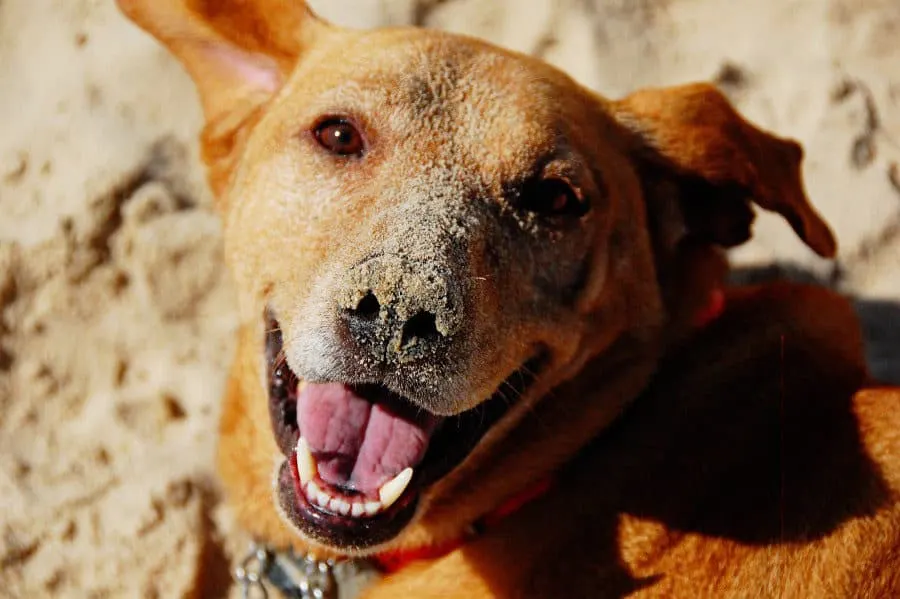Whether you are taking your dog to the beach or, like us, a weekly getaway to a lake beach, it’s important to take precautions to make sure your dog doesn’t get into trouble with the potentially deadly elements of extreme heat and water. We’re always aware of many risks but there’s one that might not be on your radar: dry drowning in dogs.

We just received a list from Petplan pet insurance, who noted that claims rise in the summer for everything from dehydration to blocked bowels to to beach vacations.
One item particularly caught our eye: dry drowning. We’ve heard of this sad occurrence after a child has enjoyed a long day at the beach or pool but hadn’t heard about it in relation to dogs–but now we’ll be especially cognizant of this potential hazard.
Top 5 Summer Hazards for Dogs
Here are Petplan’s top five summer hazards for dogs:
Sunburn
Believe it or not, dogs can get sunburned—and white or light-colored pets are most at risk.
To keep pups safe, apply sunscreen to the bridge of the nose, ear tips, abdomen and inner legs, and always provide plenty of shade.
Use pet-formulated sunscreens only: many human sunblocks contain zinc oxide, which is toxic to pets if ingested.
Snacking on sand

Lots of dogs like to dig in the sand, but some wind up eating the fruit of their labor.
A little sand will not hard your dog, but large quantities can collect in the intestines or bowels and cause a blockage.
Signs of trouble include straining to defecate with no result, lack of appetite, repeated vomiting or abdominal discomfort (look for heavy panting, pacing, whining or a distended belly). Keep a close eye during play to prevent accidental snacking.
Sipping alt water
Petplan’s vets warn never to let a dog drink seawater. The most common side effect is diarrhea, but if they sip enough of it, salt toxicity becomes an issue.
Too much salt causes a major electrolyte imbalance in dogs, which can lead to dehydration, brain damage, kidney failure and even death. Always pack fresh drinking water and a portable pet bowl.
Dry drowning
Dogs who enjoy swimming should never do so unattended. A dog can be pulled under by strong tides and currents—or even just exhaustion—and may aspirate water while struggling.
This inhaled water can cause pulmonary edema (fluid in the lungs that can lead to respiratory distress or cardiac arrest).
Dry drowning can happen hours or even days after a near-drowning accident, and it can be deadly. Protect your pup with a pet lifejacket to help keep his head above water.
Heat sickness
Heat stroke takes the top spot for being one of the most common—and most dangerous—threats to beach-going pets.
Not only is the condition expensive to treat (the average cost is $2,606*), but more than just your wallet can get burned: heat stroke is often fatal, and can affect a pet in as little as 15 minutes.
Avoid bringing dogs to the beach during the hottest part of the day, and be sure they’ve got access to both water and shade.
“Bringing a pet on vacation is a great way to make new memories, but it’s absolutely crucial to take safety precautions before hitting the beach,” says Petplan Staff Veterinarian Rebecca Jackson. “Know the dangers of sun, sand and salt water and how to minimize your pet’s risk of getting hurt or sick. Summer sun should be fun for everyone—especially the four-legged among us!”
Pin it to remember Dry Drowning in Dogs

- Review: Jimmy BX7 Pro Anti-Mite Vacuum Cleaner - December 16, 2024
- 🎉 GIVEAWAY: Lord of the Pets Portrait of Your Dog! - November 26, 2024
- Review: Lord of the Pets Portraits - November 17, 2024
